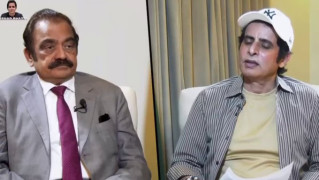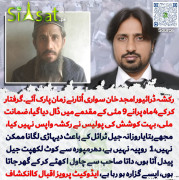THE INDIAN CLAIM TO JAMMU AND KASHMIR - A REAPPRAISAL:
by Alistair Lamb
The formal overt Indian intervention in the internal affairs of the State of Jammu and Kashmir began on about 9.00 a.m. on 27 October 1947, when Indian troops started landing at Srinagar airfield. India has officially dated the commencement of its claim that the State was part of Indian sovereign territory to a few hours earlier, at some point in the afternoon or evening of 26 October. From their arrival on 27 October 1947 to the present day, Indian troops have continued to occupy a large proportion of the State of Jammu and Kashmir despite the increasingly manifest opposition of a majority of the population to their presence. To critics of Indias position and actions in the State of Jammu and Kashmir the Government of New Delhi has consistently declared that the State of Jammu and Kashmir lies entirely within the sphere of internal Indian policy. Do the facts support the Indian contention in this respect?
The State of Jammu and Kashmir was a Princely State within the British Indian Empire. By the rules of the British transfer of power in Indian subcontinent in 1947 the Ruler of the State, Maharajah Sir Hari Singh, with the departure of the British and the lapsing of Paramountcy (as the relationship between State and British Crown was termed), could opt to join either India or Pakistan or, by doing nothing, become from 15 August 1947 the Ruler of an independent polity. The choice was the Rulers and his alone: there was no provision for popular consultation in the Indian Princely States during the final days of the British Raj. On 15th August 1947, by default, the State of Jammu and Kashmir became independent.
India maintains that this period of independence, the existence of which it has never challenged effectively, came to an end on 26/27 October as the result of two pairs of closely related transactions, which we must now examine. They are:
(a) an Instrument of Accession of Jammu and Kashmir to India which the Maharajah is alleged to have signed on 26 October 1947, and;
(b) the acceptance of this Instrument by the Governor-General of India, Lord Mountbatten, on 27 October 1947; plus
(c) a letter from the Maharajah to Lord Mountbatten, dated 26 October 1947, in which Indian military aid is sought in return for accession to India (on terms stated in an allegedly enclosed Instrument) and the appointment of Sheikh Abdullah to head an Interim Government of the State; and
(d) a letter from Lord Mountbatten to the Maharajah, dated 27 October 1947, acknowledging the above and noting that, once the affairs of the State have been settled and law and order is restored, the question of the States accession should be settled by a reference to the people.
In both pairs of documents it will be noted that the date of the communication from the Maharajah, be it the alleged Instrument of Accession or the letter to Lord Mountbatten, is given as 26 October 1947, that is to say before the Indian troops actually began overtly to intervene in the States affairs on the morning of 27 October 1947. It has been said that Lord Mountbatten insisted on the Maharajahs signature as a precondition for his approval of Indian intervention in the affairs of what would otherwise be an independent State.
The date, 26 October 1947, has hitherto been accepted as true by virtually all observers, be they sympathetic or hostile to the Indian case. It is to be found in an official communication by Lord Mountbatten, as Governor General of Pakistan, on 1 November 1947; and it is repeated in the White paper on Jammu and Kashmir which the Government of India laid before the Indian Parliament in March 1948. Pakistani diplomats have never challenged it. Recent research, however, has demonstrated beyond a shadow of a doubt that the date is false. This fact emerges from the archives, and it is also quite clear from such sources as the memoirs of the Prime Minister of Jammu and Kashmir at the time, Mehr Chand Mahajan, and the recently published correspondence of Jawaharlal Nehru, the Indian Prime Minister. Circumstantial accounts of the events of 26 October 1947, notably that of V.P Menon (in his The Integration of the Indian States, London 1965), who said he was actually present when the Maharajah signed, are simply not true.
It is now absolutely clear that the two documents (a) the Instrument of Accession, and (c) the letter to Lord Mountbatten, could not possibly have been signed by the Maharajah of Jammu and Kashmir on 26 October 1947. The earliest possible time and date for their signature would have to be the afternoon of 27 October 1947. During 26 October 1947 the Maharajah of Jammu and Kashmir was travelling by road from Srinagar to Jammu. His Prime Minister, M.C. Mahajan, who was negotiating with the Government of India, and the senior Indian official concerned in State matters, V.P. Menon, were still in New Delhi where they remained overnight, and where their presence was noted by many observers. There was no communication of any sort between New Delhi and the traveling Maharajah. Menon and Mahajan set out by air from New Delhi to Jammu at about 10.00 a.m. on 27 October, and the Maharajah learned from them for the first time the result of his Prime Ministers negotiations in New Delhi in the early afternoon of that day.
The key point, of course, a has already been noted above, is that it is now obvious that these documents could only have been signed after the overt Indian intervention in the State of Jammu and Kashmir. When the Indian troops arrived at Srinagar air field, that State was still independent. Any agreements favourable to India signed after such intervention cannot escape the charge of having been produced under duress. It was, one presumes, to escape just such a charge that the false date 26 October 1947 was assigned to these two documents. The deliberately distorted account of that very senior Indian official, V.P. Menon, to which reference has already been made, was no doubt executed for the same end. Falsification of such a fundamental element as date of signature, however, once established, can only cast grave doubt over the validity of the document as a whole .
An examination of the transactions behind these four documents in the light of the new evidence produces a number of other serious doubts. It is clear, for example, that in the case of (c) and (d), the exchange of letters between the Maharajah and Lord Mountbatten, Lord Mountbattens reply must antedate the letter to which it is an answer unless, as seems more than probable, both were drafted by the Government of India before being taken up to Jammu on 27 October 1947 (by V.P. Menon and Jammu and Kashmir Prime Minister M.C. Mahajan, whose movements, incidentally, are correctly reported in the London Times of 28 October 1947) after the arrival of the Indian troops at Srinagar airfield. The case is very strong, therefore, that document (c), the Maharajahs letter to Lord Mountbatten, was dictated to the Maharajah.
Documents (c) and (d) were published by the Government of India on 28 October 1947. The far more important document (a), the alleged Instrument of Accession, was not published until many years later, if at all. It was not communicated to Pakistan at the outset of the overt Indian intervention in the State of Jammu and Kashmir, nor was it presented in facsimile to the United Nations in early 1948 as part of the initial Indian reference to the Security Council. The 1948 White Paper in which the Government of India set out its formal case in respect to the State of Jammu and Kashmir, does not contain the Instrument of Accession as claimed to have been signed by the Maharajah: instead, it reproduces an unsigned from of Accession such as, it is imposed, the Maharajah might have signed. To date no satisfactory original of this Instrument as signed by the Maharajah ever did sign an Instrument of Accession. There are, indeed, grounds for suspecting that he did no such thing. The Instrument of Accession referred to in document (c); a letter which as we have seen was probably drafted by Indian officials prior to being shown to the Maharajah, may never have existed, and can hardly have existed when the letter was being prepared.
Even if there had been an Instrument of Accession, then if it followed the form indicated in the unsigned example of such an Instrument published in the Indian 1948 White Paper it would have been extremely restrictive in the rights conferred upon the Government of India. All that were in fact transferred from the State to the Government of India by such an Instrument were the powers over Defence, Foreign Relations and certain aspects of Communications. Virtually all else was left with the State Government. Thanks to Article 370 of the Indian Constitution of January 1950 (which, unlike much else relating to the former Princely States, has survived to some significant degree in current Indian constitution theory, if not in practice), the State of Jammu and Kashmir was accorded a degree of autonomy which does not sit at all comfortably with the current authoritarian Indian administration of those parts of the State which it holds.
Not only would such an Instrument have been restrictive, but also by virtue of the provisions, of (d), Lord Mountbattens letter to the Maharajah dated 27 October 1947, it would have been conditional. Lord Mountbatten, as Governor-General of India, made it clear that the State of Jammu and Kashmir would only be incorporated permanently within the Indian fold after approval as a result of some form of reference to the people, a procedure which soon (with United Nations participation) became defined as a fair and free plebiscite . India has never permitted such a reference to the people to be made.
Why would the Maharajah of Jammu and Kashmir not have signed an Instrument of Accession? The answer lies in the complex course of events of August, September and October 1947 emerged. The Maharajah, confronted with growing internal disorder (including a full scale rebellion in the Poonch region of the State), sought Indian military help without, it at all possible, surrendering his own independence. The Government of India delayed assisting him in the hope that in despair he would accede to India before any Indian actions had to be taken. In the event, India had to move first. Having secured what he wanted, Indian military assistance, the Maharajah would naturally have wished to avoid paying the price of the surrender of his independence by signing any instrument which he could possibly avoid signing. From the Afternoon of 27 October 1947 onwards a smoke screen conceals both the details and the immediate outcome of this struggle of wills between the Government of India and the Maharajah of Jammu and Kashmir. To judge from the 1948 White Paper an Instrument of accession may not have been signed by March 1948, by which time the Indian case for sovereignty over Jammu and Kashmir was already being argued before the United Nations.
The patently false dates of documents (a) and (c) alter fundamentally the nature of the overt Indian intervention in Jammu and Kashmir on 27 October 1947. India was not defending its own but intervening in a foreign State. There can be no reasonable doubt that had Pakistan been aware of this falsification of the record it would have argued very differently in international for from the outset of the dispute; and had the United Nations understood the true chronology it would have listened with for less sympathy to arguments presented to it by successive Indian representatives. Given the facts as they are now known, it may well be that an impartial international tribunal would decided that India had no right at all to be in the State of Jammu and Kashmir.
The Indian Claim to Jammu and Kashmir - Conditional Accession, Plebiscites and the Reference to the United Nations:
While the date, and perhaps even the fact, of the accession to India of the State of Jammu and Kashmir in late October 1947 can be questioned, there is no dispute that at that time any such accession was presented to the world large as conditional and provisional. In his letter to the Maharajah of Jammu and Kashmir, bearing the date 27 October 1947, the Governor General of India, Lord Mountbatten, declared that:
"Consistently with that in the case of any State where the issue of accession has been the subject of dispute, the question of accession should be decided in accordance to the wishes of the people of the State, it is my Governments wish that as soon as law and order have been restored in Kashmir and her soil cleared of the invaders the question of the States accession should be settled by a reference to the people."
The substance of this was communicated by Jawaharlal Nehru to Liaquat Ali Khan in a telegram of 28 October 1947 in which Nehru indicated that this was a policy with which he agreed. The point is clear enough. A reference to the people would be entirely futile unless it contained the potential of reversing the process of accession. If the people opted for Pakistan, or indeed, for continued independence, then any documents relating to accession which the Maharajah may have signed would be null and void. Such documents would perforce be provisional, in that they could confer rights only until the reference to the people took place; and they were conditional in that they could not continue in force indefinitely unless ratified by popular vote. This point is as valid today as it was in late October 1947.
Indian apologists have since endeavored to argue that the plebiscite proposal was personal to Mountbatten (which we can see it was not) and that it was in a real sense ex-gratia and in no way binding on subsequent Indian administrations. The fact of the matter, however, was that the plebiscite policy had been established long before the Kashmir crisis erupted in October 1947. It was an inherent part of the process by which the British Indian Empire was partitioned between the two successor Dominions of India and Pakistan. Plebiscites (or referenda-the terms tended to be used at this time as if they meant the same thing) had been held on the eve of the Transfer of Power in August 1947 in two areas. In the North West Frontier Province, which possessed a Congress Government despite a virtually total Muslim population, and in Sylhet, a Muslim majority district of the non-Muslim majority Province of Assam, there had been plebiscites where the people were given the choice of joining India or Pakistan. In both cases the vote was in favour of Pakistan. The Sylhet Plebiscite is of particular significance in that it gave a Muslim majority district of a State with an overall non-Muslim majority the opportunity to join its Muslim majority neighbour, Bengal.
The value of the plebiscitary process continued to be appreciated in India after the British Indian Empire had come to an end. In September 1947 the Government of India advocated, as a matter of policy, the holding of a plebiscite in the Princely State of Junagadh. Junagadh was in many respects the mirror image of Kashmir. Here a Muslim Ruler, the Nawab, had formally acceded to Pakistan on 15 August 1947 despite the fact that the overwhelming majority of his subjects were Hindus. The Government of India were united in opposing this action. However, as Jawaharlal Nehru put it on 30 September 1947 :
"We are entirely opposed to war and wish to avoid it. We want an amicable settlement of this issue and we propose therefore, that wherever there is a dispute in regard to any territory, the matter should be decided by a referendum or plebiscite of the people concerned. We shall accept the result of this referendum whatever it may be as it is our desire that a decision should be made in accordance with the wishes of the people concerned. We invite the Pakistan Government, therefore, to submit the Junagadh issue to a referendum of the people under impartial auspices."
In Indian eyes, in other words, Junagadhs accession to Pakistan, if it had any validity at all could only be provisional and conditional upon the outcome of a plebiscite of referendum. India, moreover, considered that the need for such a reference to the people was specifically determined by the fact that a majority of the States population followed a different religion to that of the Ruler. A plebiscite in Junagadh was duly held in February 1948, when the vote was for union with India. In Indian official thinking, it is clear, there was no question of a plebiscite in any State where both Ruler and people were non-Muslims.
Thus when the Kashmir crisis broke out in October 1947 the plebiscite was already established as the official Indian solution to this order of problem. On 25 October 1947, before the Kashmir crisis had fully developed and before Indian claims based on the Maharajahs accession to India had been voiced, Nehru in a telegram to Attlee, the British Prime Minister, declared that:
"I should like to make it clear that [the] question of aiding Kashmir..is not designed in any way to influence the State to accede to India. Our view, which we have repeatedly made public, is that [the] question of accession in any disputed territory must be decided in accordance with the wishes of the people, and we adhere to this view."
On 28 October 1947 the Governor General of Pakistan M.A. Jinnah, also agreed that the answer to Kashmir lay in a plebiscite, thus confirming the official Pakistan policy on this subject. From this moment the basic disagreement between the two Dominions, at least on paper, lay in the modalities for holding a plebiscite and what was understood by impartial auspices.
The concept of impartial supervision of the determination of sovereignty had been present from the outset of the run up to the partition of the Punjab and Bengal in early June 1947. A number of possibilities had been considered at this period, including the request for the services of the United Nations (which had then been rejected on technical grounds arising in the main from the short span of time allowed for the partition process to be implemented). In connection with the Junagadh question, on 30 September 1947 Nehru made it clear that if the United Nations were to be involved (as a result, perhaps, of a reference to that body by Pakistan), and the United Nations issued directions, India would naturally abide by those directions.
Between 28 October and 22 December 1947 there took place a series of Indo-Pakistan discussions over the Kashmir question, some with the leaders of the two sides meeting face to face, some through subordinate officials and some through British intermediaries acting either officially or unofficially. While frequently acrimonious, the general tenor of the negotiations was that some kind of plebiscite should be held in Jammu and Kashmir. At a meeting on 8 November 1947 between two very senior officials, V.P Menon for India and Chaudhri Muhammad Ali for Pakistan, a detailed scheme for holding a plebiscite in Jammu and Kashmir was worked out, with the apparent blessing of the Indian Deputy Prime Minister, Vallabhbhai Patel, in which the following principle was laid down : that neither Government [of India or Pakistan] would accept the accession of a State whose rule was of a different religion to the majority of his subjects without resorting to a plebiscite.
The 8 November scheme aborted; but the underlying principles remained on the agenda. There were two major questions. First : how and in what way should the State be restored to a condition of tranquility such as would permit the holding of any kind of free and fair plebiscite. Second: who should supervise the plebiscite when it finally came to he held. On both question, after exploring a number of devices including the employment of British officers to hold the ring while the votes were being cast, the consensus in the Governments of both India and Pakistan by 22 December 1947 was that the services of the United Nations, either through the Secretary General or the Security Council, offered the best prospect for success, though Nehru continued to express in public his reservations about foreign intervention.
At this point Lord Mountbatten, the Governor General of India, explained to Liaquat Ali Khan, the Prime Minister of Pakistan, that the best way to get Nehru to decide finally in favour of reference to the United Nations was to permit India to take the first step, even if in the process Pakistan would have to submit to some measure of Indian indictment to which Pakistan would have every opportunity to make rebuttal at the United Nations. Liaquat Ali Khan, so the records make clear, accepted this proposal. On this basis, on 1 January 1948, India brought Security Council of the United Nations.
The Presentation of the Indian case, the Pakistani reply, and the series of debates which followed over the years, have all tended to obscure the original terms of that Indian reference. This was made under Article 35 of the Charter of the United Nations in which the mediation of the Security Council was expressly sough in a matter which otherwise threatened to disturb the course of international relations. The issue was an Indian request for United Nations mediation in a dispute which had transcended the diplomatic resources of the two parties directly involved, India and Pakistan, and not, as it is frequently represented, an Indian demand for United Nations condemnation of Pakistans aggression. This point, despite much Indian and Pakistan rhetoric, can be determined easily enough by relating the contents of the reference to the specifications of Article 35 of the United Nations Charter. The United Nations was asked to devise a formula whereby peace could be restored in the State of Jammu and Kashmir so that a fair and free plebiscite could be held to determine that States future. The matter of the Maharajah of Kashmirs accession to India was not in this context of the slightest relevance.
The Security Council of the United Nations responded to this request by devising a number of schemes for the restoration of law and order and the holding a plebiscite. These were duly set out in United Nations Resolutions which, though never implemented, still remain the collective expression of the voice of the international community as to how the Kashmir question ought to be settled. The conditions set out by the Security Council of the United Nations have not been met in any way by the subsequent internal political processes (including a variety of elections) in the State of Jammu and Kashmir and in any of its constituent parts.
The situation in the State of Jammu and Kashmir remains unresolved, and it remains a matter of international interest. Given the background to and terms of the original Indian reference to the Security Council it cannot possibly be said that, today, Jammu and Kashmir (or those parts of it currently under Indian occupation) is a matter of purely internal Indian concern. The United Nations retains that status in this matter, which it was granted by the original Indian reference, and the Security Council still has the duty to endeavor to implement its Resolutions.



































